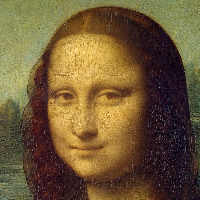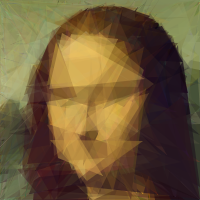Image matcher
CanvasGenitic algorithms


If you’ve written the genetic phrase matcher you may be ready for this project. Unlike in the phrase matcher where you actually know what the best solution looks like (it’s just the string that’s exactly the same as the original string) in this program, the goal is to create an image that as close as possible to a reference image but rather than by drawing individual pixels (which would just be a larger version of the phrase matcher problem) you can only draw a fixed number of semi-transparent, colored triangles. (When semi-transparent shapes overlap it produces colors that are a blend of the overlapping colors.
The structure of the algorithm should be the same as in the phrase matcher: from individual “organisms” whose fitness can be measured make a population of many members. Then loop making a new generation by producing offspring from the fittest members of the current population.
In this case each organism is somehow an ordered list of triangles (probably an array) with each triangle having a position and a color expressed as RGBA (red, green, blue, and alpha which determines the level of transparency). The fitness of each solution can be measured by drawing the triangles into a Canvas and then getting the pixel data of the generated image and comparing each pixel to the pixel in the reference image. The closer the generated image is to the reference image, the higher the fitness. The triangles need to be ordered because the the order semi-transparent colors overlap affects the resulting color.
The original version of this project (see below) used a simple scheme of asexual reproduction: starting from a single organism generate a child by mutating the original. If the new organism is fitter than its parent it takes over as the parent for the next child, otherwise the child dies and the original parent tries again. It would be interesting to experiment with sexual reproduction scheme similar to the phrase matcher to see if it can find better solutions or find them more quickly. Other variants would be to allow the number of triangles to change so some organisms would have more and some fewer. (In that case you should probably include the size of the organism in the fitness score with organism that use fewer triangles beeing more fit.)
Other possible variations are to use different shapes. The original actually used arbitrary polygons which seems like a bit of a cheat to me because it makes it a lot easier to create arbitrary shapes. But he achived better results with just fifty polygons than I’ve been able to achieve with 2,000 triangles so if you actually want to produce good images you may want to play with that. (I read about the original “Evolution of Mona Lisa” years ago and have mis-remembered it as using triangles ever since, possibly because I was thinking about GPUs which draw everything they draw with triangles.)
Note: there are some technical details you’ll need to dig into to build this such as figuring out how to use the Canvas API (which I’ve mostly hidden from you behind things like the Simple Draw environment) to get at raw pixel data. Also you’ll probably want to understand the animation loop we’ve been using so you can get better control over it. But none of that is all that complicated; I’ll point you in the right direction and help you if you get stuck.
References
- Genetic Programming: Evolution of Mona Lisa (via Wayback Machine)
- Genetic algorithim - Wikipedia